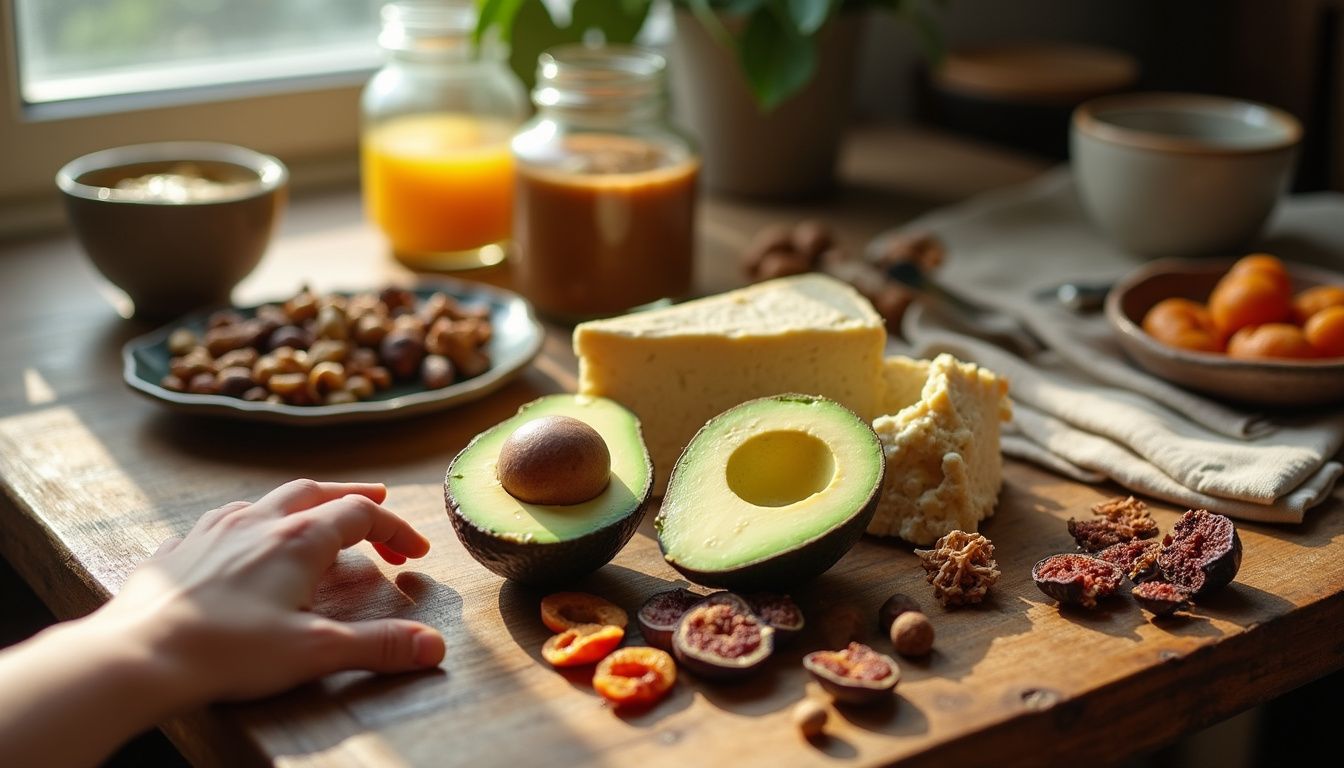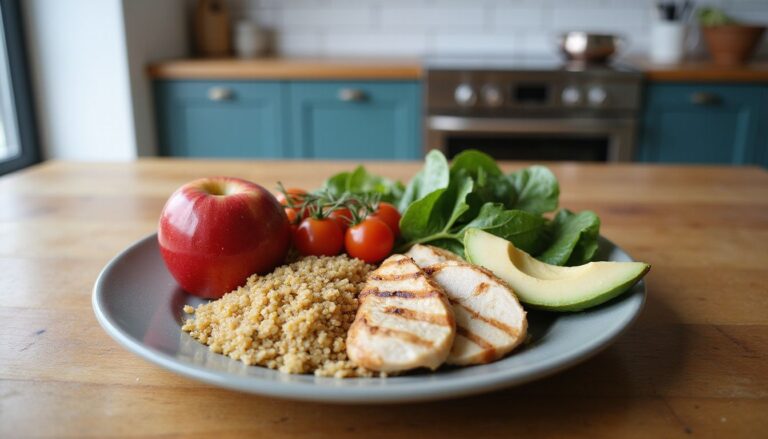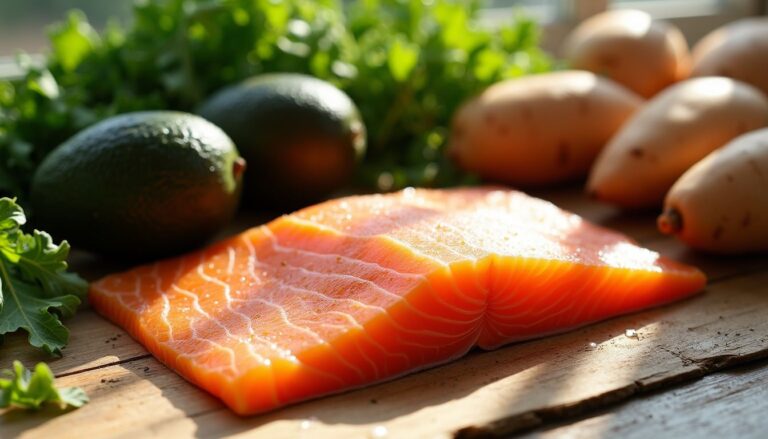Top 5 Calorie Dense Foods For Weight Gain: Boost Your Intake With High Calorie Nutrient-Dense Options
Our Nutrition Assistant AI Suite will transform your body. You will lose fat, get toned, and build muscle. Gain confidence and optimal health.
If you are trying to gain weight but struggle to eat enough, you are not alone. Calorie-dense foods make it easier to raise your calorie intake without huge portions. These choices pack a lot of energy into small bites, which helps when appetite is low.
After research and kitchen testing, I settled on five high-calorie, nutrient-dense foods that support healthy weight gain. They taste good, are easy to use, and bring important nutrients like protein, fiber, and healthy fat. I also share quick ways to add them to meals and snacks.
Use this guide to build a simple plan that fits your day. If you have a medical condition or are underweight, talk with a healthcare professional for personal advice.
Key Takeaways
- Nuts and nut butters give 160 to 200 calories per ounce or two tablespoons, plus protein, healthy fat, vitamin E, magnesium, and iron.
- Whole milk dairy provides up to 170 calories per cup and 8 grams of high-quality protein, along with calcium for bone health.
- One large avocado has about 365 calories, nearly 30 grams of monounsaturated fat, fiber, potassium, vitamin E, and B vitamins.
- A typical 3-ounce steak offers roughly 228 calories, 24 grams of protein, heme iron, and creatine to support training.
- Whole grains such as oats or rice deliver 150 to 205 calories per cooked cup and steady carbohydrates for lasting energy.
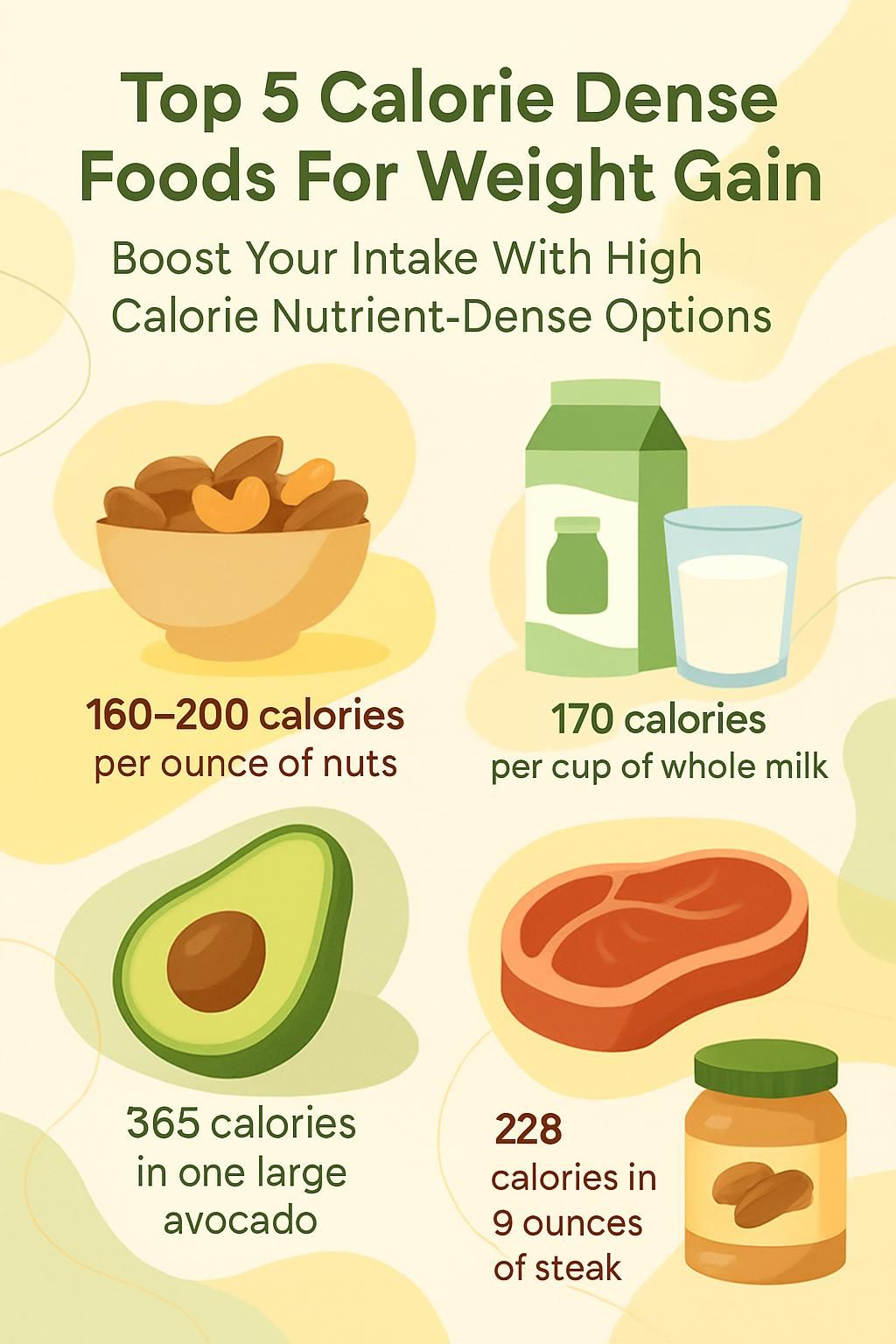
Understanding Calorie-Dense Foods for Weight Gain
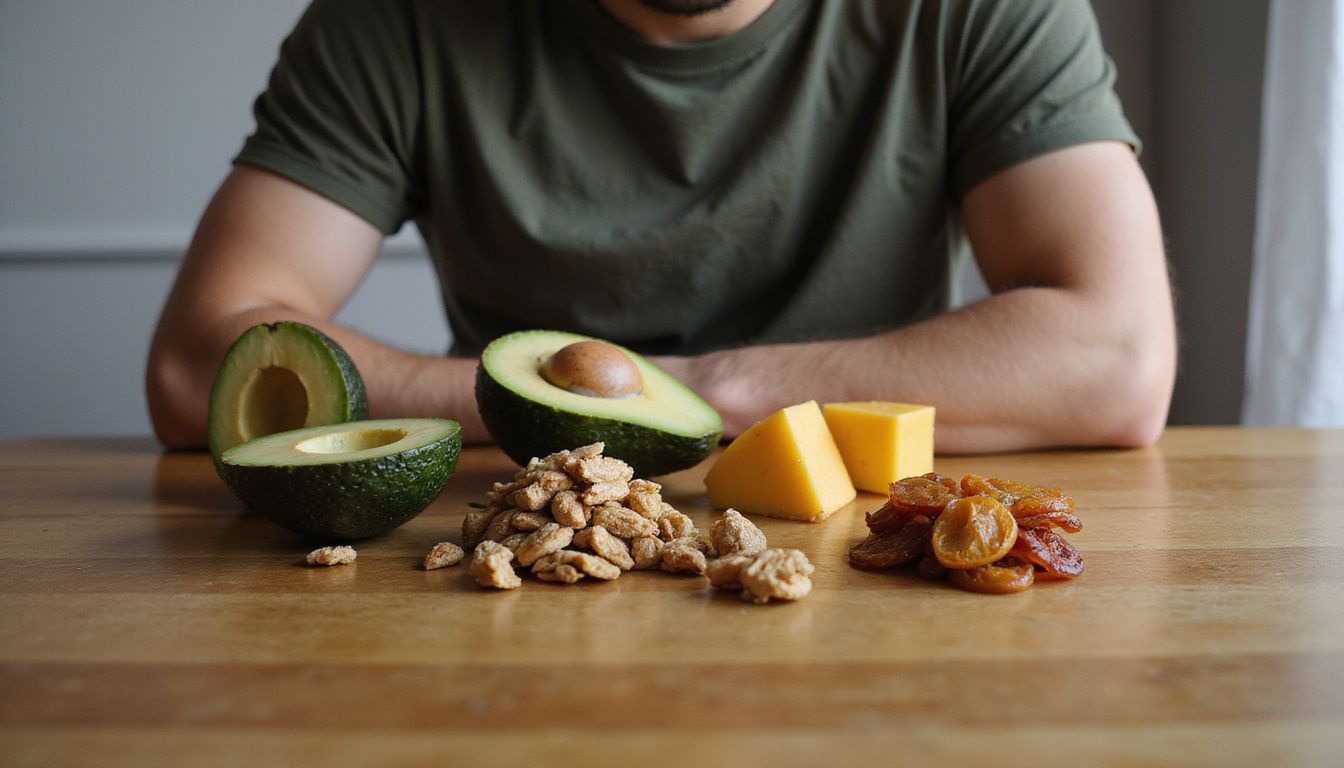
Calorie-dense foods give many calories in a small amount of food. I rely on these high-calorie choices to raise energy and nutrient intake when I need to gain weight fast.
What Are Calorie-Dense Foods?
Calorie-dense foods are high in calories per 3.5 ounces, or 100 grams. Common examples are nuts, nut butters, oils, cheese, fattier cuts of beef, butter, dried fruit, and granola.
Fat has 9 calories per gram. Protein and carbohydrates have 4 calories per gram. Alcohol has about 7 calories per gram. That is why foods higher in fat usually contain more calories per bite.
I add energy-rich choices like peanut butter on whole grain bread or full-fat yogurt with cereal to boost intake without large servings. Some packaged snacks are calorie-dense, but many lack vitamins and minerals. I prefer whole-food options like avocado or seeds to get both calories and nutrients.
How Do Calorie-Dense Foods Help You Gain Weight?
Gaining weight requires a steady calorie surplus. That means eating more calories than your body uses each day. Many women maintain weight around 2,000 calories and many men around 2,500, though needs vary by size and activity.
Foods high in fat or sugar can raise intake quickly. I pick items that bring both calories and protein, like oily fish or nut butters, because they help me eat more without feeling stuffed. These choices support athletes and anyone aiming for more muscle by adding extra energy throughout the day.
Benefits of Calorie-Dense Foods for Weight Gain
Calorie-dense foods deliver big energy and solid nutrition in small portions. They help increase body mass and support muscle growth while keeping meals manageable.
How Do Calorie-Dense Foods Provide Energy in Small Portions?
A small serving can go a long way. For example, one quarter cup, about 32 grams, of raw almonds provides 170 calories, 15 grams of fat, and 6 grams of protein. One tablespoon of olive oil adds about 120 calories to salad or pasta.
High-calorie dairy works the same way. One ounce of cheddar cheese has around 110 calories plus protein for tissue growth. These foods are easy to scatter through the day, so I reach my goals without early fullness.
“Small portions can still deliver big energy.”
Can Calorie-Dense Foods Support Muscle Growth and Recovery?
Yes. They supply both energy and building blocks for muscle. A 2018 review found that milk with strength training helped increase lean mass, since dairy provides protein and calories needed for recovery.
Red meat brings creatine and leucine. Leucine is an amino acid that turns on muscle building. A 3-ounce steak has roughly 2.5 grams of leucine. Whey protein is complete protein, meaning it has all essential amino acids. Many lifters do well at about 1.6 grams of protein per kilogram of body weight per day, based on a large review.
When I focused on strength, I blended smoothies with milk, whey powder, nut butter, and bananas. That mix gave me extra calories and enough protein for growth and repair.
What Essential Nutrients Do Calorie-Dense Foods Provide?
Nutrient-dense, high-calorie foods do more than raise the scale. Nuts and seeds supply healthy fats, fiber, protein, vitamin E, vitamin B6, magnesium, potassium, and iron.
A large avocado adds about 365 calories, around 30 grams of fat, and over 10 grams of fiber. It also provides vitamin C and helpful plant compounds. Dairy foods such as whole milk yogurt or cheese bring protein, carbs, fat, calcium, and vitamin D. Whole grains like oatmeal and brown rice offer long-lasting carbohydrates and minerals like iron and manganese.
Salmon gives quality protein and omega-3 fats that support heart health. I aim for salmon twice a week to raise omega-3 intake without loading up on added sugar or empty calories.
Five Top Calorie-Dense Foods for Weight Gain
Many foods deliver high energy density and strong nutrition for healthy weight gain. These picks work well for athletes and for people who need more calories during recovery.
Nuts and Nut Butters Overview
Nuts and nut butters are small but mighty. A quarter cup of raw almonds has 170 calories, 6 grams of protein, and 15 grams of fat. A couple of handfuls per day can move the scale in a steady way.
Nut butters, like peanut butter, add calories and protein to smoothies, cereal, and sandwiches. A Peanut Butter Banana Smoothie made with whole milk can reach about 270 calories with just three simple ingredients. If you have a nut allergy, seed butters are a good swap. I make my own almond butter sometimes so I can skip added sugar and extra oil.
What Are Examples of Nuts and Nut Butters?
Nut and seed butters give calorie-dense options that also carry key nutrients. I choose versions with no added sugar or hydrogenated oil.
- Raw almonds have about 160 calories per ounce and are rich in vitamin E, magnesium, and healthy fats.
- Peanut butter gives around 190 calories in two tablespoons. Choose 100 percent peanut for a cleaner label.
- Almond butter has about 200 calories per two tablespoons, plus protein, magnesium, and monounsaturated fat.
- Sunflower seed butter is nut free, roughly 200 calories per two tablespoons, and high in vitamin E.
- Cashew butter provides about 180 calories in two tablespoons and supplies protein for tissue repair.
- Walnuts contain omega-3 fats and about 185 calories per ounce, which supports heart health.
- Pistachios deliver nearly 160 calories per ounce plus antioxidants, potassium, and B vitamins.
What Are the Health Benefits of Nuts and Nut Butters?
Nuts and nut butters bring healthy fats, protein, fiber, and key micronutrients. Almonds give magnesium and vitamin E. Walnuts provide omega-3 fats that support the heart.
I often use peanut butter as a compact way to raise energy. One tablespoon of natural almond butter has about 98 calories and minerals like calcium and iron. Making nut butter at home lets me control the ingredients. Spreading cashew butter on fruit gives me steady energy between meals.
For muscle goals, pair nut butters with whole grain bread or oats. I also mix nuts into yogurt or serve them with dried fruit for a quick, nutrient-dense snack.
Dairy Products Overview
Dairy like whole milk and Greek yogurt are classic tools for raising calories. One cup of whole milk provides about 149 calories and 8 grams of complete protein from casein and whey. That mix supports muscle growth and helps prevent muscle loss when training.
Whole milk Greek yogurt delivers about 165 calories and 15 grams of protein per half cup. Flavored yogurt carries more calories due to added sugar, which can be useful during active weight gain. These foods also supply calcium, potassium, and vitamin D. I used full-fat dairy daily when I needed to increase my body mass index, with guidance from my doctor.
What Are Examples of High-Calorie Dairy Products?
These dairy foods make it easier to hit calorie goals while keeping nutrients high.
- Whole milk has about 150 calories per 8-ounce glass and is a strong source of calcium.
- Cheddar cheese offers roughly 110 calories and 7 grams of protein in one ounce.
- Cream cheese adds about 100 calories per two tablespoons and works well on bagels or toast.
- Whole milk Greek yogurt delivers over 170 calories per single-serving cup.
- Ice cream often has more than 200 calories per half cup, handy for shakes and desserts.
- Shredded cheddar cheese, one cup or 125 grams, provides about 314 calories for easy recipes.
- Creamy soups made with whole milk add protein, vitamins, and minerals.
- Milkshakes made with ice cream supply energy and nutrients, which helps during weight gain.
I use these choices to raise daily intake without needing very large meals.
What Are the Benefits of Dairy Products for Weight Gain?
Whole milk, yogurt, and cheese offer both protein and fat, which makes them great calorie-dense options. Whole milk dairy raises daily calories faster than low-fat versions because it carries more energy per serving.
In a 2018 review, milk plus resistance training increased muscle tissue more than training alone. I often pair yogurt or milk with grains, nuts, and fruit to build balanced meals that fit my calorie goals. Dairy also supports bones with calcium and vitamin D.
Avocados Overview
Avocados are rich in calories and healthy fats. One large fruit has about 365 calories and close to 30 grams of monounsaturated fat. These fats support heart health.
An avocado also gives fiber, potassium, vitamin E, and B vitamins. I add slices to whole grain toast or toss cubes into salads for more calories without relying on sugary snacks. Swapping mayo for mashed avocado in sandwiches brings better nutrient variety and a creamy taste.
Why Are Avocados Considered Healthy Fats?
Avocados stand out because most of their calories come from monounsaturated fat. This type of fat supports the heart and can help improve cholesterol numbers.
They also provide fiber and micronutrients like potassium and vitamin E. A serving fits well in meal plans that target muscle growth and steady energy intake. Choosing smart fat sources helps long-term health goals.
How Can You Use Avocados in Meals and Snacks?
Avocados boost calories in simple ways. I use these easy ideas when I need more energy.
- Top toast with sliced avocado for a creamy breakfast or snack, more than 150 calories per half fruit.
- Use mashed avocado in place of mayo on sandwiches and wraps for higher calorie density.
- Add diced avocado to omelets, sushi rolls, or grain bowls for extra richness and energy.
- Mix avocado into salads; the fat helps your body absorb vitamins from vegetables.
- Grill avocado halves, then fill with tuna salad or crumbled bacon for a fast lunch.
- Make guacamole to pair with chips, crackers, or veggie sticks for a higher-calorie dip.
- Blend avocado into protein smoothies with milk or milk substitutes, such as soy or oat drinks.
- Stir diced avocado into soups just before serving to add creaminess and calories.
Next I will explore which types of red meat are most effective for building muscle and supporting iron needs in weight gain diets.
Red Meat Overview
After adding avocados for healthy fats, I often turn to red meat for protein and calories. Beef is one of the most calorie-dense whole-food options that supports muscle growth.
A 3-ounce, 85 gram, steak contains about 228 calories, 24 grams of protein, and around 2.5 grams of leucine. Red meat also supplies dietary creatine, which helps muscle recovery after exercise. It provides iron that helps prevent tiredness and supports focus.
Health agencies advise keeping red meat intake moderate to manage long-term cancer risk. I plan portions with that in mind.
What Are Common Types of Red Meat?
Red meat plays a role in some weight gain plans because it brings calories, protein, and minerals.
- Steak offers about 228 calories and 24 grams of protein per 3 ounces. Fattier cuts are more calorie-dense.
- Ground beef works in tacos, chilis, and pasta sauces. Higher-fat blends raise energy per serving.
- Pork chops add flavor and calories, and support glycogen storage in muscle.
- Lamb tends to be higher in fat, so it raises calorie intake and provides iron and zinc.
- Beef ribs or brisket deliver rich taste and higher fat for those who need more calories per bite.
These choices set up the next point, how red meat supports protein and iron needs.
How Does Red Meat Support Protein and Iron Intake?
A 3-ounce steak supplies 24 grams of protein and about 2.5 grams of leucine. Protein supports muscle repair, and leucine signals muscles to build new tissue. Steak also contains creatine, which helps strength and recovery.
Red meat provides heme iron, which is easier to absorb than the iron in plants. Pairing red meat with strength training can help prevent age-related muscle loss. I use lean or moderate-fat cuts to balance calories and nutrients.
Whole Grains and Starchy Vegetables Overview
Whole grains like brown rice and oats bring complex carbohydrates, the body’s main fuel. One cooked cup of white rice has about 204 calories and 44 grams of carbs. One cooked cup of oatmeal has around 150 calories when made from half a cup dry.
Potatoes and other starchy vegetables also add energy. I often make them more calorie-dense by topping with sour cream, cheese, olive oil, or hummus. Choosing whole foods keeps added sugar low and supports healthy growth.
What Are Examples of Whole Grains and Starchy Vegetables?
These choices deliver steady energy and helpful nutrients for weight gain.
- Quinoa, about 222 calories per cooked cup, with protein, fiber, and magnesium.
- Oats, about 150 calories per half cup dry, for long-lasting carbs that support training.
- Corn, nearly 130 calories per cup, adds natural sweetness to meals.
- Buckwheat, about 155 calories per cooked cup, with iron and magnesium.
- Potatoes, roughly 160 calories per medium potato, also high in potassium.
- Sweet potatoes, about 114 calories each, provide beta-carotene for vitamin A.
- Squash, like acorn or butternut, 80 to 115 calories per cup as hearty sides.
- Root vegetables, such as carrots or parsnips, up to 120 calories per cup when roasted.
- Beans and lentils, often over 200 calories per cooked cup, add plant protein for repair.
- Wild rice, about 166 calories per cooked cup, with B vitamins for energy use.
- White rice, around 205 calories per cooked cup, fits many high-calorie plans.
Mix and match to keep meals interesting while building steady energy through carbohydrates.
How Do They Provide Sustained Energy Through Carbohydrates?
Complex carbohydrates digest slowly, so they release energy over time. That helps reduce spikes and dips in blood sugar during the day.
For athletes and active people, these carbs refill muscle glycogen, the stored form of carbohydrate. Topping grains or potatoes with calorie-dense extras, like nut butter or cheese, raises intake without a giant plate of food.
Next are specific examples of nutrient-rich whole grains and starchy vegetables ideal for weight gain.
Additional High-Calorie Nutrient-Dense Foods
I also lean on seafood, dark chocolate, dried fruit, seeds, and smoothies. These foods add calories in small portions and bring useful nutrients.
How Can Salmon and Oily Fish Help with Weight Gain?
Salmon and other oily fish give a calorie boost with quality protein. A 3-ounce serving of wild Atlantic salmon has about 155 calories, around 7 grams of fat, and 22 grams of protein.
Oily fish carry omega-3 fatty acids that support heart health. Canned salmon is budget friendly and easy to use. I add it to salads, sandwiches, or homemade rolls for extra flavor and energy. Mackerel and sardines offer similar benefits.
What Are the Benefits of Dark Chocolate?
Dark chocolate with at least 70 percent cacao has about 600 calories per 100 grams. It also contains antioxidants that may lower oxidative stress and support the heart.
In a 2023 study, people with kidney disease who ate 40 grams of dark chocolate three times per week saw lower inflammation. I add dark chocolate pieces to cereal, trail mix, or fruit bowls to boost both taste and calories without a large volume of food.
Next, I will discuss why including dried fruits and seeds can be useful when aiming for healthy weight gain.
Why Include Dried Fruits and Seeds in Your Diet?
Dried fruits and seeds are concentrated sources of calories and nutrients. They store well and are easy to add to meals.
- Dried fruit is energy-dense; for example, two Medjool dates have about 130 calories.
- They provide antioxidants and micronutrients that support repair and protect cells.
- The natural sugars pair well with protein foods like yogurt or cheese for balanced snacks.
- Seeds such as chia and flax add calories and fiber, which supports digestion.
- Many seeds contain minerals like magnesium, iron, and zinc for daily function.
- Dried fruit travels well and fits into oatmeal, yogurt, and trail mix.
- Seeds raise the calorie density of smoothies or baked goods and add omega-3 fats.
Dried fruit and seeds help you reach calorie targets while staying nutrient-dense.
How Do Protein Smoothies Support Calorie Intake?
Protein smoothies make it easy to raise calories without large meals. A homemade Chocolate Banana Nut Shake or Vanilla Berry Shake can land between 400 and 600 calories.
Adding whey protein powder increases both calories and protein for recovery. Each blend delivers vitamins and minerals along with steady fuel for training. This has helped me meet higher goals even on busy days.
How to Add Calorie-Dense Foods to Your Diet
Small changes can raise daily intake without discomfort. I use simple add-ons and quick prep so higher-calorie eating fits my routine.
How to Include Nuts and Seeds in Meals and Snacks?
These ideas make nuts and seeds a regular part of your day.
- Sprinkle chia or flax on oatmeal, cereal, or yogurt for a mineral boost.
- Spread nut butter on whole grain crackers or toast for healthy fat and calories.
- Blend peanut or almond butter into smoothies. One tablespoon adds about 90 to 100 calories.
- Mix chopped nuts into salads, rice bowls, or pasta for texture and energy.
- Carry snack packs of mixed nuts or trail mix for quick calorie-dense bites.
- Bake muffins, bread, or granola bars with walnuts or sunflower seeds for extra calories.
- Top apple slices with nut butter for a fast, balanced snack.
What Are Ways to Cook with Full-Fat Dairy?
Full-fat dairy raises calories and adds rich flavor. Here are ways I use it in meals.
- Use whole milk in milkshakes, soups, and sauces to increase calories and nutrients.
- Add cheese to pasta dishes like mac and cheese for a big energy boost.
- Top hot cereals or baked potatoes with sour cream or full-fat yogurt.
- Whisk heavy cream into eggs or mashed potatoes for a richer texture and more calories.
- Melt butter over vegetables or stir it into rice for extra flavor and energy.
- Bake with cream cheese or whole-milk yogurt for denser, higher-calorie desserts.
- Stir ricotta or cottage cheese into lasagna and casseroles for protein and calories.
How Can You Incorporate Avocados into Salads and Sandwiches?
Avocados lift calorie and nutrient density in everyday meals. These swaps are simple and tasty.
- Spread mashed avocado on whole grain toast, about 80 calories per ounce.
- Add diced avocado to salads. Half an avocado gives around 120 calories.
- Replace mayonnaise with avocado for higher vitamin E and healthy fats.
- Layer slices into wraps to raise calories and add magnesium for recovery.
- Stir chopped avocado into chili or soups as a hearty garnish.
- Pair avocado with grilled chicken or salmon in sandwiches for protein plus healthy fat.
- Use mashed avocado instead of butter on bagels or English muffins.
- Layer avocado with tomato and lettuce in club sandwiches for extra nutrition.
- Toss chunks into quinoa or brown rice salads for a satisfying, higher-calorie meal.
What Cooking Techniques Use Healthy Oils Effectively?
Healthy oils raise calories and help absorb fat-soluble vitamins A, D, E, and K. I use them in these ways.
- Sauté vegetables, lean red meat, or starchy vegetables with 1 tablespoon of olive oil, about 120 calories.
- Drizzle olive or walnut oil over salads or whole grains before serving.
- Pan-sear salmon in sunflower or avocado oil to add essential fatty acids.
- Roast potatoes or root vegetables with coconut or olive oil for richer flavor.
- Blend a teaspoon of butter or coconut oil into morning coffee for a calorie-dense drink.
- Toss cooked pasta or grains with avocado or sunflower oil for extra energy.
- Use healthy oils in homemade sauces to raise flavor and calories without excess sugar.
Key Tips for Weight Gain Success
Simple habits make healthy weight gain easier. I focus on pairing energy with nutrients and keeping portions steady through the day.
How to Combine Calorie-Dense with Nutrient-Dense Foods?
Pair energy with quality nutrition to get more from each bite. I add avocado to whole grain toast for calories, fiber, vitamins, and healthy fats.
Mix nuts or seeds into Greek yogurt for protein and minerals like magnesium and potassium. Use full-fat dairy instead of low-fat to lift calories and add calcium. Grill salmon and serve it with sweet potatoes to combine omega-3s with steady carbs. Serving red meat with leafy greens can improve iron absorption.
This method helps me meet calorie targets without depending on low-nutrient snacks.
How to Manage Portion Sizes to Avoid Overeating?
I aim for three meals plus snacks, then a small bedtime snack. I sip most fluids after meals so I do not fill up too early.
Small plates help me serve an amount that fits my goals. This keeps me from overshooting, even with calorie-dense foods like nuts, full-fat dairy, and avocado. Tracking a few days can show what works for your body.
Why Avoid Empty-Calorie Processed Foods?
Foods like pastries, candy, chips, and sugary drinks add calories but few nutrients. They may raise intake fast, but they do little for strength, recovery, or long-term health.
I tried chips and soda during a busy week. My weight nudged up, but I felt sluggish and did not recover well from workouts. Switching to nuts, seeds, and whole grains improved energy while still raising calories.
Frequently Asked Questions
Here are clear answers on calorie needs, safety, and muscle building with high-calorie foods.
What Is the Recommended Calorie Intake for Weight Gain?
Healthy weight gain needs a consistent surplus. Many adult women maintain weight around 2,000 calories daily, and many men around 2,500. I usually add 300 to 500 calories per day to gain at a steady pace.
The Dietary Guidelines for Americans suggest 45 to 65 percent of calories from carbohydrates, 10 to 30 percent from protein, and 20 to 35 percent from fat. A calorie is a unit of energy in food. Higher numbers mean more fuel for growth and recovery.
My dietitian advised tracking intake, since needs vary by age, sex, activity, and goals. I adjust portions based on progress, not guesses.
Are There Health Risks with Calorie-Dense Foods?
Large amounts of some high-calorie foods can raise health risks. Keep red meat moderate to reduce colorectal cancer risk. Some calorie-dense foods are high in saturated fat, which can affect heart health if eaten too often.
Alcohol is calorie-dense with little nutrition. The CDC suggests up to one drink daily for women and up to two for men, with each drink containing about 14 grams of pure alcohol. If your BMI is high or you have health concerns, speak with a registered dietitian before major changes.
How Do Calorie-Dense Foods Help with Muscle Building?
They supply the extra energy and protein needed to add muscle during lifting. Protein powders like whey, soy, egg, or pea help many people reach about 1.6 grams of protein per kilogram of body weight each day.
Red meat and dairy provide leucine and creatine, which support muscle protein synthesis and recovery. A 2018 review found milk plus resistance training boosted lean mass more than training alone. Choosing calorie-dense foods that also carry vitamins and minerals helps add muscle rather than only body fat.
Conclusion
Choosing high-calorie, nutrient-dense foods makes weight gain simpler and healthier. Nuts, dairy, avocados, red meat, and whole grains deliver energy in small servings and bring the protein, fiber, and minerals your body needs.
Mix these foods into meals and snacks you already enjoy. This approach helped me raise calories without feeling overly full. If you need a tailored plan, reach out to a registered dietitian or your physician for guidance. This article is for education and does not replace medical advice.
FAQs
1. What are calorie dense foods and how do they help with weight gain?
Calorie dense foods contain a high number of calories in small portions. These options provide energy and support tissue growth, which is important for healthy weight gain.
2. Which minerals should I look for in high calorie nutrient-dense foods?
Foods rich in essential minerals such as calcium, magnesium, and potassium help maintain strong bones and proper body function while increasing your caloric intake.
3. How much extra food should I eat to see results if my goal is weight gain?
A daily surplus of about 500 calories can lead to a steady increase of around 2.2 pounds per month according to clinical nutrition data; this supports gradual tissue development without excess fat accumulation.
4. Can you give an example from personal experience about using these foods for healthy weight gain?
After adding more nuts, seeds, avocados, oily fish, and full-fat dairy products into meals each day along with monitoring mineral intake, noticeable improvements appeared in both muscle mass and overall energy levels within several weeks.
Summary: Calorie dense foods that supply vital nutrients like minerals play a key role in supporting tissue health during intentional weight gain efforts. Consistent dietary adjustments paired with careful tracking can yield measurable progress over time according to evidence-based guidelines.

